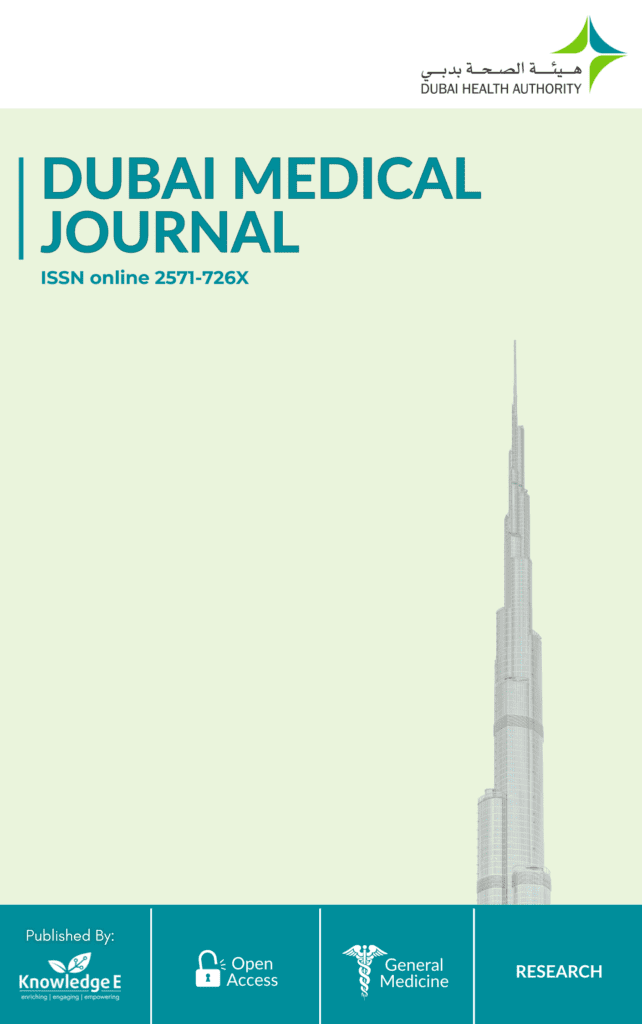
Dubai Medical Journal
ISSN: 2571-726X
Pioneering research in medicine, health sciences, nursing, pharmaceuticals, and laboratory work
Recurrent Right-side Bell’s Palsy in Association with Neurovascular Cross-compression: A Case Report
Published date: Jul 26 2024
Journal Title: Dubai Medical Journal
Issue title: Dubai Medical Journal (DMJ): Volume 7 Issue 2
Pages: 55 - 62
Authors:
Abstract:
Introduction: Bell’s palsy is a lower motor neuron (LMN) palsy that affects the facial nerve (CN VII) and causes weakness or paralysis of the facial muscles. It can be associated with various causes, including neurovascular cross-compression (NVCC). This case report highlights the challenges in treating recurrent Bell’s palsy caused by NVCC and the need for a multidisciplinary approach.
Case report: A 17-year-old girl presented with recurrent right-side Bell’s palsy along with NVCC involving the right and left anterior inferior cerebellar artery forming a loop around the VII and VIII cranial nerve complex. Motor Nerve Conduction Studies (NCS) indicated a right-side facial nerve lesion with prolonged distal latency.
Discussion: Despite prior physiotherapy sessions, which proved effective, the patient showed no improvement after five sessions, leading to further investigations. This case also underscores the diagnostic and therapeutic complexities associated with NVCC-induced Bell’s palsy, which emphasizes the urgency of quick diagnosis and intervention to prevent functional limitations.
Conclusion: Continued research and advancements in diagnostic and therapeutic modalities are required for better outcomes and improving the quality of life in such patients, particularly in such cases.
Keywords: Bell’s palsy, neurovascular compression syndrome, recurrent
References:
[1] Warner MJ, Hutchison J, Varacallo M. Bell palsy. StatPearls [Internet]; 2023. https://www.ncbi.nlm.nih.gov/books/NBK482290/
[2] Javed K, Daly DT. Neuroanatomy, lower motor neuron lesion. StatPearls [Internet]; 2023. https://www.ncbi.nlm.nih.gov/books/NBK539814/
[3] Christensen B. House-Brackmann classification of facial function. Medscape. 2023. Accessed June 11, 2024. https://emedicine.medscape.com/article/2172449-overview?form=fpf
[4] Anukoolwittaya P, Hiransuthikul A, Thanprasertsuk S, Phanthumchinda K. Combined four neurovascular compression syndromes: the first case report and literature review. Egypt J Neurol Psychiatr Neurosurg. 2023;59(1):1–5.
[5] Mat Lazim N, Ismail H, Abdul Halim S, Nik Othman NA, Haron A. Comparison of 3 grading systems (House-Brackmann, Sunnybrook, Sydney) for the assessment of facial nerve paralysis and prediction of neural recovery. Medeni Med J. 2023;38(2):111.
[6] Traylor KS, Sekula RF, Eubanks K, Muthiah N, Chang YF, Hughes MA. Prevalence and severity of neurovascular compression in hemifacial spasm patients. Brain. 2021;144(5):1482.
[7] Khan AJ, Szczepura A, Palmer S, Bark C, Neville C, Thomson D, et al. Physical therapy for facial nerve paralysis (Bell’s palsy): An updated and extended systematic review of the evidence for facial exercise therapy. Clin Rehabil. 2022;36(11):1424.
[8] Kim JH, Goo B, Nam SS. Efficacy of laser therapy on paralysis and disability in patients with facial palsy: a systematic review of randomized controlled trials†. Healthcare (Switzerland). 2023;11(17).
[9] Zhang W, Xu L, Luo T, Wu F, Zhao B, Li X. The etiology of Bell’s palsy: a review. J Neurol. 2020;267(7):1896–1905.
[10] Peng W, Zhao R, Guan F, Liang X, Jing B, Zhu G, et al. Fully endoscopic microvascular decompression for the treatment of hemifacial spasm, trigeminal neuralgia, and glossopharyngeal neuralgia: a retrospective study. BMC Surg. 2023;23(1):331.
[11] Patankar AP. Microvascular decompression for hemifacial spasm: a review of twenty-one operated cases. Egypt J Neurol Psychiatr Neurosurg. 2020;56(1):1–4.
[12] Szmyd B, Sołek J, Błaszczyk M, Jankowski J, Liberski PP, Jaskólski DJ, et al. The underlying pathogenesis of neurovascular compression syndromes: a systematic review. Front Mol Neurosci. 2022;15:923089.